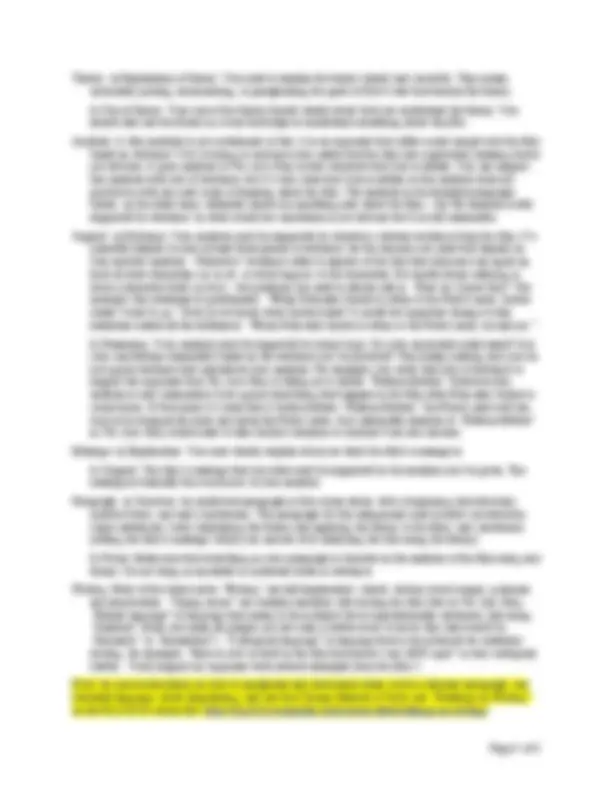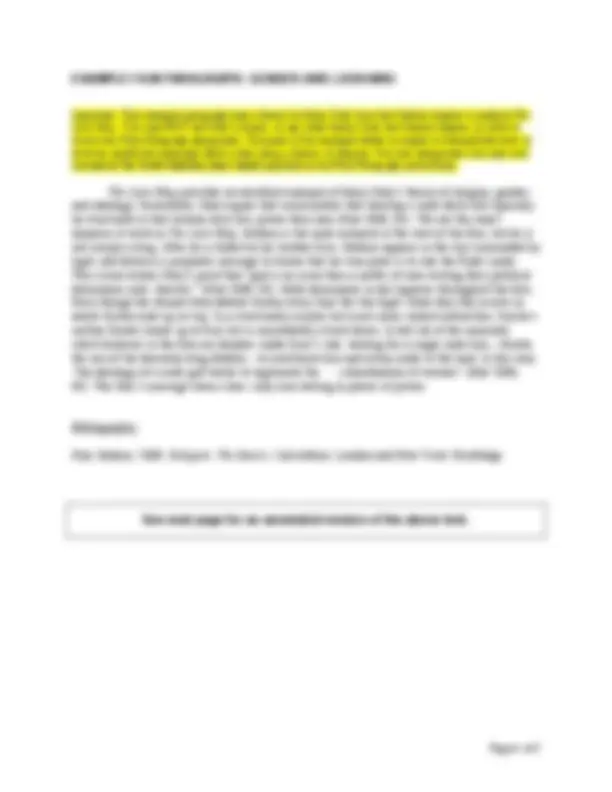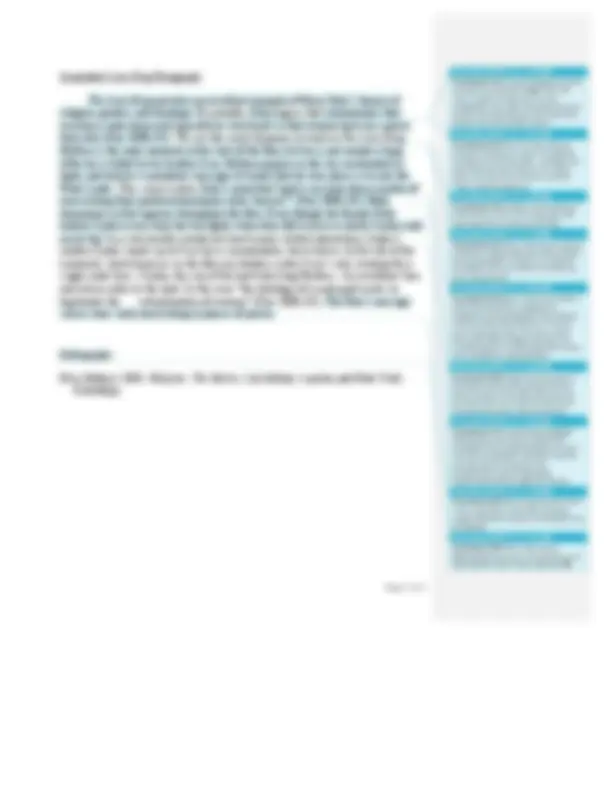





Study with the several resources on Docsity

Earn points by helping other students or get them with a premium plan


Prepare for your exams
Study with the several resources on Docsity

Earn points to download
Earn points by helping other students or get them with a premium plan
Community
Ask the community for help and clear up your study doubts
Discover the best universities in your country according to Docsity users
Free resources
Download our free guides on studying techniques, anxiety management strategies, and thesis advice from Docsity tutors
Instructions and guidelines for a university assignment where students are required to write a film paragraph analyzing a non-religious film using one of three religious theories from the textbook 'Religion: The Basics'. The assignment aims to help students understand the application of theoretical material to data and improve their academic writing skills.
Typology: Study notes
1 / 5

This page cannot be seen from the preview
Don't miss anything!




Assignment As explained in the Film Paragraph instructions, your task is to write a single paragraph analyzing a “non- religious” film using one of the following theories from chapter 5 of Nye’s Religion: The Basics : reductionism (p. 108–9); cognitive vs. affective beliefs (p. 117); habitus (p. 124–6)!. You must use ONE of these three theories; if you use a different theory, you may be penalized up to 10 marks (out of 20). Assignment Goals One aim of this project is for you to see something that is familiar to you (a film!) in a new way, by looking at it through the lens of a particular theory from the academic study of religion. Another aim of this assignment is for you to become familiar with the application of theoretical material to data, which is a key activity of scholars in most disciplines. A final goal is for you to (hopefully!) have fun with this assignment. Really! Film Analysis Repeat viewings: We strongly recommend that you watch your film at least twice in order to do your Film Paragraph assignment. When you go to write the final Film Analysis due on Feb. 16 (which will require you to use two additional theories), you should watch your film at least one more time again. As you start to develop your analysis, each new time you see the movie you should notice details and connections that you missed before. Theory: The first step in your analysis will be to fully understand the theory you have chosen. Read over Nye’s explanation carefully, summarizing what you see as the key elements of the theory. The next step is to look for possible connections between the theory and the film. These connections could involve any aspect of the film – images, words, songs, plot, etc. Feel free to focus on any part of the movie you like — you can look at a minor character, or just one scene. The point is to think about the connections that you see and find interesting or meaningful. Analysis: Once you’ve identified connections between the theory and the film, you must use these links to analyze the film. It’s not enough to simply identify the connections themselves; you have to try to understand what these connections might mean. In other words, when you look at the film using the theory you have selected, what message do you think the film is trying to convey? Message: The message that you identify must be applicable to the world outside of the film (i.e., our world!). In The Lion King , for example, you can use Richard Gombrich’s theory of cognitive and affective beliefs to show that Simba should accept his responsibilities to the community as king of the Pride Lands. And so the question is: how is this message relevant to the film’s viewers? Most of us aren’t lions or kings (!). However, it is possible to argue that the film is saying that we ALL have responsibilities in life, and that each of us must live up to these responsibilities. “Religion”: Do not concern yourself with explicitly identifying “religious” aspects of the film. We simply want you to apply a theory of belief to a film. We are not asking you to argue that the film is “religious” in any way. No research: It is critical that you do this assignment using only Nye’s description of the theory you have chosen, and your own observations of the film. Do not use any additional research on the theory or the film. We want you to engage both the film and the theory directly, and tell us what you think. Ultimately, your analysis will be evaluated on how well you have understood the theory, taken into account evidence from the film, and reasonably supported your analysis using only that evidence.
Writing Difficulty: Writing is difficult, and academic writing can be particularly challenging. To do your best, it is always good to start early and give yourself lots of time to think, write, and revise. Also: ask for help! Help: Many people want to help you succeed in writing this analysis. You should not hesitate to ask for assistance from your TA, your instructor, or the lovely and talented folks at the UTM Robert Gillespie Academic Skills Centre (http://www.utm.utoronto.ca/asc). Starting your assignment early will mean that these folks will be able to offer you more focused and useful advice, but if you are stuck in any way at any point, you should talk to someone. Clarity: Your paragraph should clearly communicate your points. Do not write like Calvin! You should never write in a way that sounds “academic” but actually says nothing interesting or meaningful or comprehensible. Citations: Use the Chicago Manual of Style (author- date format) for your citations and bibliography. See the example paragraph below. To quote or not to quote?: When explaining a theory it’s often best to summarize it or rephrase it in your own words (=paraphrase). This will show your own understanding of the theory. If you do quote directly, you must use quotation marks. Whether you quote from Nye’s text or use your own words to explain a theory, you must always provide the appropriate citations to Nye’s text. You can see how to cite references to ideas from Nye’s text in the example paragraph below. Advice on how to summarize and paraphrase is available here: http://advice.writing.utoronto.ca/using-sources/paraphrase/ Academic integrity: Academic integrity is essential to the university, but students often commit offences unintentionally. To avoid doing this please read the UofT document, “How Not to Plagiarize”: http://www.writing.utoronto.ca/advice/using-sources/how-not-to-plagiarize. Grading Rubric Make sure you copy the grading rubric into your Film Paragraph assignment, just after your bibliography. The rubric is available from the course Blackboard site under “Film Analysis.” The bottom portion of the rubric is quantitative , and identifies specific grade penalties that will be applied if you do not follow the assignment instructions. For example, if you neglect to include a title page, a penalty of one ( 1 ) point will be applied. Please pay careful attention to this list, and avoid unnecessary grade deductions. The top portion of the rubric is qualitative. This means that there are no specific marks associated with each of the items in the rubric. The point of a qualitative rubric is to show you the various elements that are important for this assignment; these are the elements that we will be looking at when we determine what grade you have earned. Below you will find some explanations of each element.
Important: This example paragraph uses a theory by Mary Daly from the Gender chapter to analyze The Lion King. You may NOT use Daly’s theory, or any other theory from the Gender chapter, in order to write your Film Paragraph assignment. The point of the example below is simply to demonstrate how to write an analytical paragraph about a film using a theory of religion. For your assignment you may only use one of the three theories about belief specified in the Film Paragraph instructions.
Annotated Lion King Paragraph: The Lion King provides an excellent example of Mary Daly’s theory of religion, gender, and ideology. Essentially, Daly argues that communities that worship a male deity will typically be structured so that women have less power than men (Nye 2008, 85). We see this exact dynamic at work in The Lion King. Mufasa is the male monarch at the start of the film, but he is not simply a king. After he is killed by his brother Scar, Mufasa appears in the sky surrounded by light, and delivers a prophetic message to Simba that his true place is to rule the Pride Lands. This scene evokes Daly’s point that “god is no more than a matter of men writing their political dominance onto ‘heaven’” (Nye 2008, 85). Male dominance in fact appears throughout the film. Even though the female Nala defeats Simba every time the two fight, when they fall in love as adults Simba ends up on top. In a structurally similar but much more violent interaction, Simba’s mother Sarabi stands up to Scar but is immediately struck down. In fact all of the unnamed, silent lionesses in the film are helpless under Scar’s rule, waiting for a single male lion – Simba, the son of the heavenly king Mufasa – to overthrow him and return order to the land. In this way “the ideology of a male god works to legitimate the... subordination of women” (Nye 2008, 85). The film’s message seems clear: only men belong in places of power. Bibliography: Nye, Malory. 2008. Religion: The Basics , 2nd edition. London and New York: Routledge. Ken Derry� 2018-1-17 11:19 AM Comment [1]: You!must!begin!by!clearly! stating!the!paragraph’s! topic .!This!may! take!a!couple!of!sentences.!For!this! assignment,!your!topic!sentence(s)!should! clearly!and!concisely!state!the!connection! between!the!film!and!the!theory.!! Ken Derry� 2018-1-17 11:04 AM Comment [2]: The!first!time!that!you! mention!a!theorist!in!a!piece!of!academic! writing,!use!their!full!name!–!and!then!just! their!surname!afterwards.!So!it’s!“Mary! Daly’!in!the!previous!sentence!and!then! “Daly”!from!this!point!on.! Ken Derry� 2018-1-17 11:05 AM Comment [3]: Include!a!brief!summary! of!the!theory!early!in!the!paragraph,!and! then!show!how!it!relates!to!the!film.! Ken Derry� 2018-1-17 11:18 AM Comment [4]: This!is!the!correct!citation! format!for!Chicago!Manual!of!Style!(authorI date).!Remember:!Citations!are!required! for! every !reference!to!Nye’s!text!(not!just! direct!quotations).! Ken Derry� 2018-1-17 11:07 AM Comment [5]: Here!is!the!first!evidence! given!from!this!film!to!support!the! argument!of!the!paragraph.!This!evidence! consists!of!brief!descriptions!of!relevant! parts!of!the!film.!Here,!the!case!is!made! that,!while!Mufasa!begins!the!film!as!an! earthly!king,!he!is!transformed!after!death! into!a!being!that!seems!godIlike.! Ken Derry� 2018-1-17 11:20 AM Comment [6]: Explain!the!key!parts!of! the!theory!clearly!and!concisely.!Put!the! theory!in!your!own!words!when!you!can,! but!quotations!are!totally!fine!(just!keep! the!quotations!short!and!to!the!point).! Ken Derry� 2018-1-17 11:20 AM Comment [7]: Continuing!to!highlight! links!between!the!theory!and!the!film! throughout!the!paragraph!helps!to!ensure! that!your!paragraph!is!analytical,!and!not! just!descriptive.!Doing!this!also! demonstrates!that!you!genuinely! understand!(and!can!apply)!the!theory.! Ken Derry� 2018-1-17 11:16 AM Comment [8]: The!paragraph!ends!with! a!clear!statement!of!the!film’s!message,! supported!by!the!analysis!in!the!body!of!the! paragraph.! Ken Derry� 2018-1-17 11:21 AM Comment [9]: This!is!the!correct! bibliography!format!for!Chicago!Manual!of! Style!(authorIdate).!Please!copy!this!!!!!